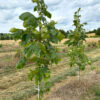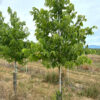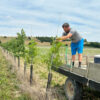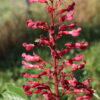
For April, we are featuring an under-used performer for the shrub border or high-canopied shady areas, the bottlebrush buckeye, Æsculus parviflora. One of eight species of buckeye native to North America, it occupies a relatively small native range from the Savannah River west across central Georgia and Alabama and south to the Florida panhandle, but easily adapts to cooler climates as far north as Chicago and Portland, Maine.

In its native mid-south, Æ. parviflora form dense stands along bluffs and ravines and in high-shaded forests. Typically maturing at 8 to 12 feet in height, it tends to slowly spread laterally by suckering so that a single individual may cover 25 feet in width at maturity. In the landscape, the coarse texture and smooth light grey bark make an excellent backdrop for smaller shrubs and perennials. Like most buckeyes, leaves emerge from large buds relatively late in the season; the large, palmate leaves with 5 to 7 leaflets usually provide a dense dark-green cover to the shrub from the ground up. The showy white flowers, peppered with red anthers, are produced in cylindrical bottlebrush-like spires up to a foot long in early summer when few other plants are in flower. The foliage usually turns a clear butter yellow in early autumn. Unlike in its native range, Æ. parviflora rarely sets fruit in the landscape.

As a landscape plant, bottlebrush buckeye is low-maintenance. Pruning is rarely required and although suckering, the shrub spreads slowly so that unwanted new shoots can be easily removed. It has no significant pests, although it can suffer from leaf scorch in prolonged periods of hot, dry weather. It prefers a moist, well-drained soil in full sun, but is also very tolerant of light shade and can perform well in drier situations if regularly watered for the first few years while becoming established.

Like their closest relatives, the maples (Acer); buckeyes contain saponins in their leaves and fruit. Saponins are defensive compounds that impart a bitter taste thus discouraging browsing. They are also especially toxic to cold-blooded vertebrates; native Americans used the ground buckeye fruits and other saponin-containing plants to stun fish in ponds and other stagnant bodies of water. Buckeye fruits (so-called because they are shiny brown with a yellowish attachment scar, much like a deer’s eye) were also commonly used in tanning leather.
White House Natives supplies Æsculus parviflora in sizes from 3 ft to 6 ft. It is a deserving native that can be a welcome addition to the shrub border.





